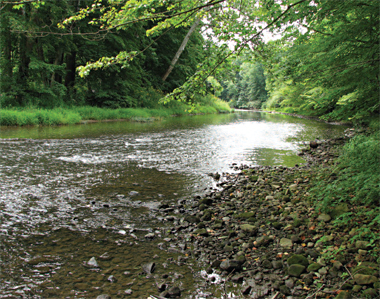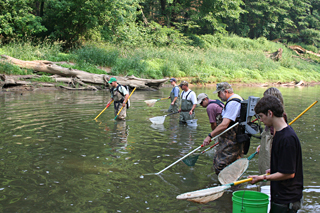Protecting our Region’s Rivers & Streams
Access to adequate supplies of clean water has emerged as a central concern for the 21st century. In Western Pennsylvania, many of our rivers and streams remain damaged by abandoned mine drainage, and some face serious threats caused by sediment from dirt and gravel roads, agricultural waste runoff or poorly implemented natural resource extraction. However, other waterways in the region have remained pure throughout the decades, and today represent precious natural resources to protect.

Wolf Creek
In 2009, the Western Pennsylvania Conservancy worked both to protect our pristine rivers and streams and to repair polluted waterways.
In total, we protected 182 miles of rivers and streams, improved more than 11 miles of dirt and gravel roads, and stabilized more than 7,800 feet of eroding stream banks. In addition, we planted 650 acres of trees, plants and grasses near river and stream banks to safeguard water quality.
A few of the numerous watershed projects completed by WPC in 2009 included:
- Spring Creek in Centre County: The Conservancy installed 4,495 feet of stream-bank fencing; three stabilized stream crossings for livestock, and numerous trees to help prevent runoff.
- Little Mahoning Creek in Indiana County: To stabilize stream banks and provide wildlife habitat, we installed 31 multi-log veins and one rock vein, plus added vegetation to areas adjacent to the stream.
- Snake Spring Valley Run in Bedford County: Stabilized 2,400 feet of a barnyard to reduce impacts to the stream.
- Four Mile Run in Westmoreland County: We added eight structures and installed a modified mudsill to stabilize the stream bank, plus placed boulders to provide wildlife habitat and influence stream flow.
- Willow Creek in Bradford County: To stabilize the stream bank, we added numerous structures including three log-faced stone deflectors, five multi-log veins and a 60-foot mudsill crib. We also created two acres of wetlands to limit erosion and provide habitat.

WPC staff and volunteers work at Little Mahoning Creek
We also improved water quality throughout the region by assisting farmers, landowners, grassroots watershed organizations and businesses. We repaired or replaced 11 on-lot septic systems — major sources of groundwater contamination — and we improved 59 agricultural operations. In addition, we made 176 improvements to properties that reduce the impacts of business activities, farms or residences on our water resources. We accomplished this work while assisting 94 conservation groups.
The Conservancy received a Western Pennsylvania Environmental Award, as well as a WTAE Earth Friend award, in 2009 for our Saving Little Mahoning Creek initiative.
